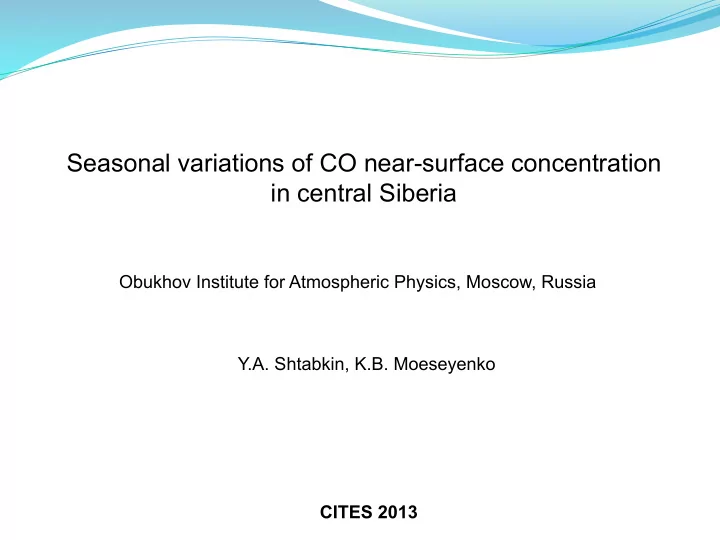

Seasonal variations of CO near-surface concentration in central Siberia Obukhov Institute for Atmospheric Physics, Moscow, Russia Y.A. Shtabkin, K.B. Moeseyenko CITES 2013
Rationale 1) Knowledge of a background atmospheric composition is a necessary prerequisit for correct assessmnet of the role of natural and anthropogenic sources in the regional balance of chemicaly active and green-house species. 2) In previos studies (A.V. Vasilyeva, K.B. Moeseyenko, A.I. Skorokhod, 2007-2011) we analysed the impact of regional transport from wildfires and industrial regions of the south Siberia on near-surface abundance of NOx and CO at ZOTTO. 3) In this work we conduct a series of numerical experiments to better quantify the relative input of all the major sources of CO (anthropogenic, biogenic, wildfires) into the ZOTTO near-surface CO as well as the role of atmospheric long-range transport in the regional CO balance.
Motivation 1)Measurements of background near-surface air composition variations can help to evaluate the impact of anthropogenic and natural factors on regional balance of chemically active and greenhouse gases in regions, traditionally known as non- polluted. 2) International networks of monitoring stations do not cover territory of Russia. This gap is to be partially filled with the measurements from the background surface air monitoring station ZOTTO(Zotino Tall Tower Observatory, http:// www.zottoproject.org, 60°48 ′ N, 89°21 ′ E, 114 m above sea level) conducted since early 2007.
ZOTTO measurements: CO2, CH4, CO, Ozone, NOx and aerosols at different heights, meteorology at different heights and on the ground (Temperature, Wind, Humidity), biweekly flask sampling at 301 m height and various irregular ecosystem measurements Background character of the station provide an excellent opportunity to study regional as well as long- range impact of various climatically important sources of pollutants including regional industry and wildfires. zottoproject.org
Methods and approaches 1) CO emission inventories: Anthropogenic (EDGAR 3.2, http://edgar.jrc.ec.europa.eu, annual) Biogenic (VOC oxidation, MEGAN 2.1, http://bai.acd.ucar.edu/ MEGAN/,annual) Wildfires(GFED 3, http://www.globalfiredata.org, monthly) 2) Global chemical-transport model GEOS-Chem v9-01-03, 4 х 5 deg., 47 vertical levels up to ~67 km (http://acmg.seas.harvard.edu/geos). 3) Separation of different sources and geographical regions in numerical simulations.
Pic. 1 Regions used for Co emission impact evaluation: NETR – north of ЕТР , SETR – south and midland of ЕТР , NS – north of Siberia, SWS – south of western Siberia, SES – south of eastern Siberia , NFE – north of Far East, SFE – south of Far East, EU — western Europe Atmospheric response = delta (CO)/ 1 Tg of CO emissions for these region Atmospheric load = delta(CO) = Total CO emission for 1 month
Air tranport during cold and warm seasons
Athmospheric load from regional anthropogenic sources (from 2007 - 2011, monthly averaged) South of european territory of Russia South-Western Siberia Europe Minor input from north of european territory of Russia, northern Siberia, south-eastern Siberia, northern Far East and southern Far east
Athmospheric load from regional biogenic sources (from 2007 - 2011, monthly averaged) South of european territory of Russia Northern Siberia South-Western Siberia South-Eastern Siberia Northern Far East Europe
Athmospheric load from regional wildfires (from 2007 - 2011, monthly averaged) North of european territory of Russia South of european territory of Russia Northern Siberia South-Western Siberia South-Eastern Siberia Northern Far East Southern Far East
Results:Total atmospheric load for ZOTTO from different regions, 2007-2011 year averaged Warm season (June - August) Cold season (December - February)
Summary and conclusions » CO responce at ZOTTO, ppbv 1) Anthropogenic emissions The main impact has the regions SETR, SWS and EU Min Average Max 7.1 31.1 72.3 2) Biogenic VOC oxidation The main impact has the regions SETR, SWS and NS Min Average Max 0.3 12.5 32.8 3) Emissions from wildfires The main impact has the regions SETR, SWS and NFE Min Average Max <0.1 6.2 25.2 These results will be used in our subsequent study to interpret seasonal and long-term variability of the near-surface air composition in central Siberia as well as at ZOTTO observational site.
Recommend
More recommend